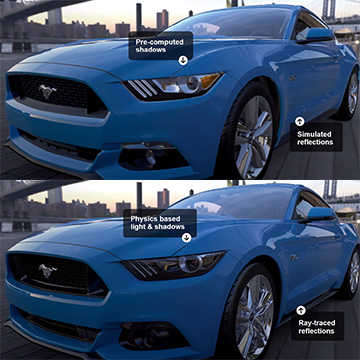![]()
Courtesy of Elizabeth Baron
In the first visionary talk of the all-virtual FiO+LS 2020 conference on Monday, 14 September, Elizabeth Baron, Unity Technologies, USA, guided attendees through a personal retelling of her unconventional, three-decade-long (and counting) career in virtual reality—and how it was both inspired and affected by her imperfect vision. In the hour-long session, Baron described her understanding of visual perception as someone who was born without stereoscopic vision, and how her perception and her work in VR changed after having her vision surgically corrected later in life.
Accommodating amblyopia
As an immersive-realities specialist who pioneered Ford Motor Company’s immersive-systems division and created the Ford immersive Vehicle Environment (FiVE) process and technology, Baron has decades of experience helping teams to visualize and collaborate through VR. For that reason, it would surprise many to learn that she was born with amblyopia, a condition that made her stereo-blind. In addition to amblyopia, which left her with one dominant and one recessive eye, Baron’s eyes were also misaligned, preventing her from fixing this unevenness with glasses.
“I saw most of the world out of my right eye,” says Baron. “I had a compromised view of the world and a skewed look at things.” Specifically, Baron didn’t have stereopsis, the ability to converge. Her peripheral vision was limited, particularly on her left side, and she couldn’t triangulate to judge depth.
In addition to being told she would never be a fighter pilot—a crushing blow to a young child, Baron recalls—her condition made her interested in photography and optics because she knew that she saw the world in a way different from other people. “This made me think more about 3D and how people experience it,” says Baron. “It was special for me to take a 3D world and put it on a screen and share it with people.”
Gamifying product design
When Baron started at Ford in 1988, she applied this unique point of view to her career and eventually became the company’s first immersive-realities specialist. “It was like I worked at a startup inside of a multinational corporation,” explains Baron. “I had to be scrappy—I kept chipping away at the virtual-reality stuff and eventually it turned into a global enterprise.”
Baron’s vision was to combine art and science to link up teams and enable them to connect physically and virtually to the product and the data. In the automotive industry, this translated to immersive-reality systems that allow engineers and designers to look at a vehicle during the creation process, and to embed the manufacturing process into the car design in real time.
During the presentation, Baron showed examples of this process at work—sharing photos of herself wearing a VR headset while walking around a vehicle, peering under the hood, sitting inside the car and even switching modes and looking at the optical data of the car’s headlights. Baron notes that this doesn’t always call for a VR headset. However, a headset works well when considering the craft and quality of a product, she explains, because the pixels consolidate and the resolution improves the closer you get, so you can get a better view.
Visual acid trip
An immersive-reality system that Baron designed before her surgery (top), and then updated with real-time ray tracing after her surgery (bottom) to accurately convey light and shadow. [Enlarge image]
While working at Ford, Baron had surgery to correct her stereo blindness, after which “I had a new view of the world,” she says. “I now have depth perception at macro and micro vision, which is huge. I have periphery, so I can see fully that the world is wide, and it's pretty amazing."
One jarring result, says Baron, is that post-surgery she began to pick up more information from people’s faces and from simple scenes—“a visual acid trip,” according to her husband. “There's a perception and presence that you get from depth views that has a cognitive and emotional component,” explains Baron. This new volumetric understanding of the world led her to try and quantify what was new and different in her visual perception and to try and apply this new reality to her work.
She began to notice miscues in the way that the cars would appear in the immersive-reality systems she designed pre-surgery, so she applied real-time ray tracing to accurately represent light and shadow. (See the comparison of the systems before and after applying ray tracing.)
An immersive future
Now, as an enterprise solutions executive at the software company Unity Technologies, Baron says that both the technology and the time to use it are here. “We’re embarking on a culture change where we can do better in the way people work, collaborate and share. The time is right to take these concepts and have a platform to visualize cross-functional data."
In an immersive future, she explains, there is a call for gamifying industrial design, and the optical community can help to tell product stories to continue those experiences and show them in context. One specific need the community could address, Baron suggests, would be to make a really wide-field-of-view headset. Every headset on the market now is a compromise, she says, “and there can be a device that is both AR and VR and does optical see-through that can be dialed in or out.”

